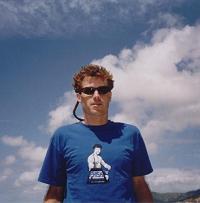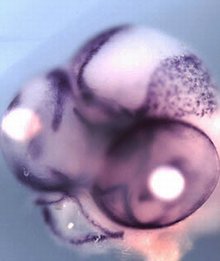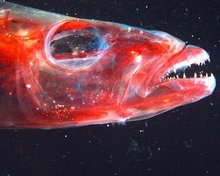One Animal's Body, Another Animal's Brain
 Recent advances in genetic research have allowed scientists to grow the brain of one animal inside he body of an entirely different species. Is this the dawning of a new era or a scene out of
Recent advances in genetic research have allowed scientists to grow the brain of one animal inside he body of an entirely different species. Is this the dawning of a new era or a scene out of The Island of Dr. Moreau?
The idea of splicing animals together isn’t a new one The ancient Greeks fashioned a chimera out of a snake, a goat, and a lion; the Japanese made a baku out of an ox, an elephant, and a tiger. Even today, people are inventing new creatures -only now, they’re using a lot more than their imaginations.
Just ask biologist Todd Streelman. Inside his lab at Georgia Tech, Streelman successfully bred a living animal with the brain of anther species. He started with a cichlid, a type of fish found in Lake Malawai, at the southern tip of Africa’s Great Rift Valley. Over the past 500,000 years, hundreds of different species of the cichlid have evolved from a single ancestor, with each new species developing a distinct set of jaws, teeth, brain, and behaviors to fit their respective environments. Streelman took two species of cichlid fish -rock-dwelling cichlids and sand-dwelling cichlids- and figured out a way to grow a sand-dweller’s brain inside the skull of a rock-dweller. From a distance, that might seem like a simple trick in cross-pollination. But it’s no small feat when you consider that the brains of the two creatures are as different as those of chimpanzees and humans.

ANIMAL CROSSING
How’d he do it? The trick to Streelman’s success was figuring out how (and when) the brains of different species distinguish themselves during embryonic development. In the earliest stages of life, the brain of almost every animal starts out looking the same. It begins as a small sheet of rapidly dividing cells that are not yet designed for different functions. But this sheet of cells eventually rolls into a tube, and the cells turn into different types of neurons. The neurons then slowly forms connections uniquely tailored to the creature’s lifestyle. In humans, for example, the brain develops a large cerebral cortex capable of processing language and consciousness. In various species of cichlid fish, the forebrain changes and grows depending on its future environment. More specifically, the sand-dweller’s forebrain develops a large hind region for surviving in open water, while the rock-dweller’s forebrain develops a large front region to navigate Lake Malawi’s murky, cavernous bottom.
In both species, the size and shape of the forebrain is determined by the expression of a gene called Wnt1. In sand-dwellers, this gene sends out a strong signal, while in rock-dwellers, Wnt1’s signal is weak. As part of his study, Streelmen took rock-dweller embryos and placed them in water treated with lithium chloride -a salt that’s known to increase the strength of the Wnt1 signal. This caused the rear section of the rock-dweller’s brain to grow until its brain looked like that of a sand-dweller. In other words, by simply changing the expression of a single gene, Streelman was able to Frankenstein a new fish.

OF MICE AND MEN
While Streelman has proven that he can grow one species’ brain inside another’s body, there’s no telling if his patchwork creations can survive in their natural environments. To date, most attempts to manipulate neural development in animals have led to brains that look promising in the land but fail to function in the real world. In 2002, for instance, researchers manipulated a mouse’s genetic signals to increase the size of its cerebral cortex. The cortex grew dramatically, forming folds indicative of the intelligence in high-order mammals and humans. But the mutation proved fatal, and the mouse died before it was born.
Some scientists posit that the mouse’s death may have had more to do with the complex relationship between the animal and environment and less to do with ill-suited manipulation. Georg Striedner, and evolutionary biologist at the University of California at Irvine, has found that many animals go through a phase during early development in which they’re particularly vulnerable to injury, starvation, or disease. In order for an animal to survive, something in their external world has to protect them. For instance, many species go through a prolonged period of rapid cell division before their brains become neurons. This ultimately leads to a larger brain, but it also means that the animal’s brain is not fully formed at birth. Parrots are a good example. After parrots hatch, their brains aren’t particularly developed, which forces the babies to rely on their mothers for food. That means that the mothers’ feeding behaviors must have evolved at the exact same time that parrots evolved to have larger brains. Otherwise, parrots would have never become so smart.

The process of evolving new traits is clearly complicated. Labs can create animals with shiny new traits, but that doesn’t mean the animals can handle the complexity of the world around them. As for Streelman’s fish, no one knows how their manipulated brains will affect their behavior -or, for that matter, how they’ll fare in nature. In many ways, though, that isn’t the point. The goal of Streelman’s research isn’t to grow new and funky animals; it’s to learn how animals evolve. By discovering the relationship between the animal’s genome and its brain development, scientists ultimately hope to pinpoint the genetic basis of of human thought and behavior. It just may be that, along the way, creatures like the chimera and the baku become more than the stuff of ancient folklore.
Just ask biologist Todd Streelman. Inside his lab at Georgia Tech, Streelman successfully bred a living animal with the brain of anther species. He started with a cichlid, a type of fish found in Lake Malawai, at the southern tip of Africa’s Great Rift Valley. Over the past 500,000 years, hundreds of different species of the cichlid have evolved from a single ancestor, with each new species developing a distinct set of jaws, teeth, brain, and behaviors to fit their respective environments. Streelman took two species of cichlid fish -rock-dwelling cichlids and sand-dwelling cichlids- and figured out a way to grow a sand-dweller’s brain inside the skull of a rock-dweller. From a distance, that might seem like a simple trick in cross-pollination. But it’s no small feat when you consider that the brains of the two creatures are as different as those of chimpanzees and humans.

Todd Streelman
ANIMAL CROSSING
How’d he do it? The trick to Streelman’s success was figuring out how (and when) the brains of different species distinguish themselves during embryonic development. In the earliest stages of life, the brain of almost every animal starts out looking the same. It begins as a small sheet of rapidly dividing cells that are not yet designed for different functions. But this sheet of cells eventually rolls into a tube, and the cells turn into different types of neurons. The neurons then slowly forms connections uniquely tailored to the creature’s lifestyle. In humans, for example, the brain develops a large cerebral cortex capable of processing language and consciousness. In various species of cichlid fish, the forebrain changes and grows depending on its future environment. More specifically, the sand-dweller’s forebrain develops a large hind region for surviving in open water, while the rock-dweller’s forebrain develops a large front region to navigate Lake Malawi’s murky, cavernous bottom.
In both species, the size and shape of the forebrain is determined by the expression of a gene called Wnt1. In sand-dwellers, this gene sends out a strong signal, while in rock-dwellers, Wnt1’s signal is weak. As part of his study, Streelmen took rock-dweller embryos and placed them in water treated with lithium chloride -a salt that’s known to increase the strength of the Wnt1 signal. This caused the rear section of the rock-dweller’s brain to grow until its brain looked like that of a sand-dweller. In other words, by simply changing the expression of a single gene, Streelman was able to Frankenstein a new fish.

Cichlid embryo
While Streelman has proven that he can grow one species’ brain inside another’s body, there’s no telling if his patchwork creations can survive in their natural environments. To date, most attempts to manipulate neural development in animals have led to brains that look promising in the land but fail to function in the real world. In 2002, for instance, researchers manipulated a mouse’s genetic signals to increase the size of its cerebral cortex. The cortex grew dramatically, forming folds indicative of the intelligence in high-order mammals and humans. But the mutation proved fatal, and the mouse died before it was born.
Some scientists posit that the mouse’s death may have had more to do with the complex relationship between the animal and environment and less to do with ill-suited manipulation. Georg Striedner, and evolutionary biologist at the University of California at Irvine, has found that many animals go through a phase during early development in which they’re particularly vulnerable to injury, starvation, or disease. In order for an animal to survive, something in their external world has to protect them. For instance, many species go through a prolonged period of rapid cell division before their brains become neurons. This ultimately leads to a larger brain, but it also means that the animal’s brain is not fully formed at birth. Parrots are a good example. After parrots hatch, their brains aren’t particularly developed, which forces the babies to rely on their mothers for food. That means that the mothers’ feeding behaviors must have evolved at the exact same time that parrots evolved to have larger brains. Otherwise, parrots would have never become so smart.

Cichlid fish
_______________________
Shameless Screen Grab courtesy of Neatorama
It's SCIENCE! You Fools. SCIEEENNCE!
No comments:
Post a Comment